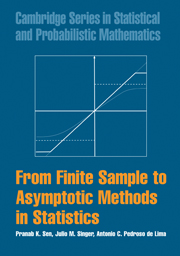Book contents
- Frontmatter
- Contents
- Preface
- 1 Motivation and Basic Tools
- 2 Estimation Theory
- 3 Hypothesis Testing
- 4 Elements of Statistical Decision Theory
- 5 Stochastic Processes: An Overview
- 6 Stochastic Convergence and Probability Inequalities
- 7 Asymptotic Distributions
- 8 Asymptotic Behavior of Estimators and Tests
- 9 Categorical Data Models
- 10 Regression Models
- 11 Weak Convergence and Gaussian Processes
- Bibliography
- Index
9 - Categorical Data Models
Published online by Cambridge University Press: 05 June 2012
- Frontmatter
- Contents
- Preface
- 1 Motivation and Basic Tools
- 2 Estimation Theory
- 3 Hypothesis Testing
- 4 Elements of Statistical Decision Theory
- 5 Stochastic Processes: An Overview
- 6 Stochastic Convergence and Probability Inequalities
- 7 Asymptotic Distributions
- 8 Asymptotic Behavior of Estimators and Tests
- 9 Categorical Data Models
- 10 Regression Models
- 11 Weak Convergence and Gaussian Processes
- Bibliography
- Index
Summary
Introduction
In general, categorical data models relate to count data corresponding to the classification of sampling units into groups or categories either on a qualitative or some quantitative basis. These categories may be defined by the essentially discrete nature of the phenomenon under study (see Example 1.2.11 dealing with the OAB blood classification model) or, often for practical reasons, by the grouping of the values of an essentially continuous underlying distribution (e.g., shoe sizes: 5, 5½, 6, 6½, etc. corresponding to half-open intervals for the actual length of a foot). Even in the qualitative case there is often an implicit ordering in the categories resulting in ordered categorical data (i.e., ratings: excellent, very good, good, fair, and poor, for a research proposal under review). Except in some of the most simple cases, exact statistical analysis for categorical data models may not be available in a unified, simple form. Hence, asymptotic methods are important in this context. They not only provide a unified coverage of statistical methodology appropriate for large sample sizes but also suggest suitable modifications, which may often be appropriate for moderate to small sample sizes. This chapter is devoted to the study of this related asymptotic theory.
Although there are a few competing probabilistic models for statistical analysis of categorical data sets, we will find it convenient to concentrate on the product multinomial model, which encompasses a broad domain and plays a key role in the development of appropriate statistical analysis tools.
- Type
- Chapter
- Information
- From Finite Sample to Asymptotic Methods in Statistics , pp. 273 - 292Publisher: Cambridge University PressPrint publication year: 2009



